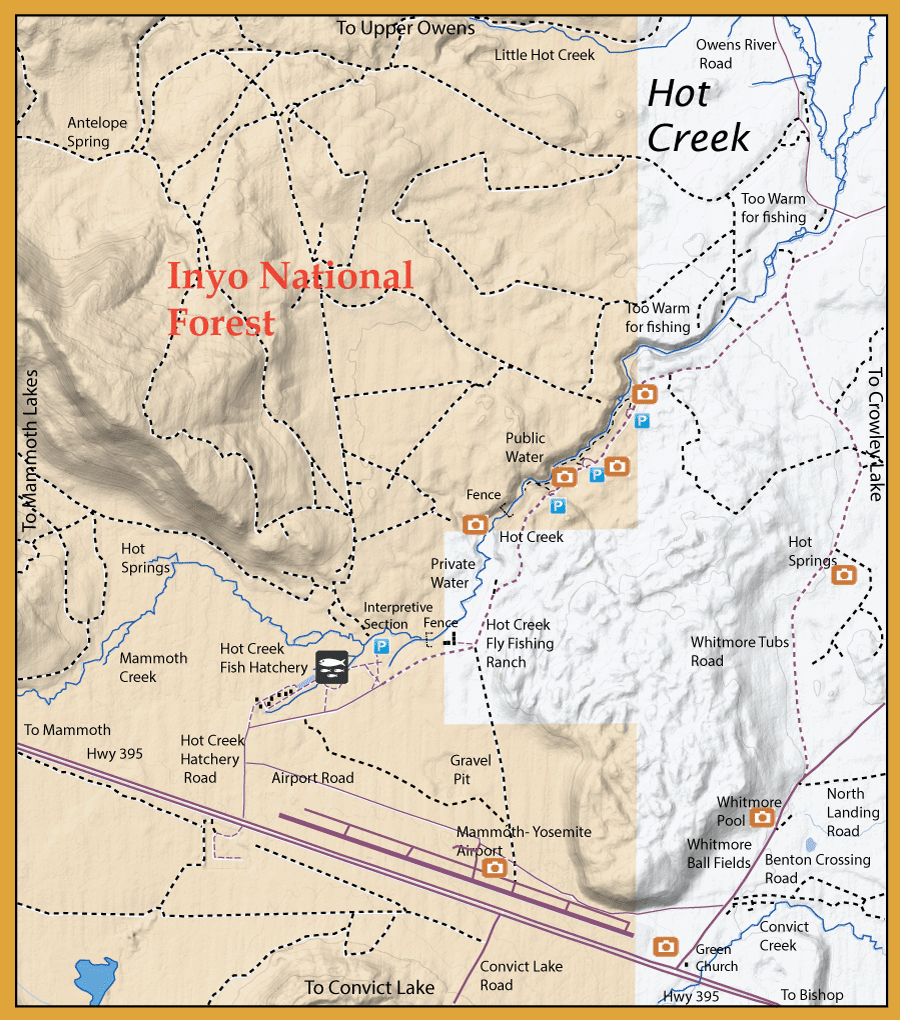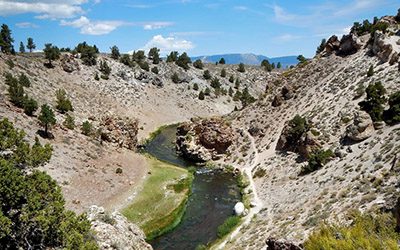Hot Creek – the ideal spring creek year round

Directions: | ||
Fishing Report: Hot Creek Flow Report: Hot Creek
| ||
Notes:
Hot Creek is a small stretch of Spring Creek water that comes flowing out of volcanic rocks just above the Hot Creek Fish Hatchery. The stream flows at 9,000 gallons per minute with a consistent temperature of 60 to 69 degrees. This consistent supply and water temperature was the reason for building the fish hatchery at this site in 1941. Just below the hatchery, Hot Creek is fed by Mammoth Creek, upstream. Mammoth Creek brings oxygenated and colder snowmelt water to the mix, contributing about 20% of the volume. This blending of water produces the perfect trout water of a slightly high pH, minerals, nutrients, and a consistent water temperature of 50 to 60 degrees year round. There is only about 1 mile of this perfect stream available until the thermal springs occur. The Interpretive area is just below the fish hatchery and the confluence of Mammoth Creek. It has a gazebo with signage of the fish and the water. You can fish this section up to the Hot Creek Ranch fenceline. The Interpretive Section is only about a 1/4 mile long and has some deep pools with some very big trout, including the one that Dr. Kutzke caught in 2006. Hot Creek RanchHot Creek Ranch is a private facility providing cabins and private access to fly fishers. In 1950, the ranch mandated dry fly fishing only, catch & release. Probably, the first trout water within the United States to implement that restriction. No wading is allowed. Hot Creek meanders through a grassy meadow for about 1.5 miles through the ranch. No wading is allowed. Fishing at the Ranch is limited to guests only and is open from the last Saturday in April to November 15th. Below the ranch is public water once again. There are 3 main areas to park with trails going down into the canyon gorge. This water is strictly C & R with barbless flies and is open year-round. Hot Creek was designated a “Wild Trout Water” by the State in 1980. Hot Creek can be heavily fished and the fish will be very wary of the presentation. Hot Creek Fish HatcheryOne of the reasons for the high fish numbers within Hot Creek is the proximity of the Hot Creek Fish Hatchery just upstream. Hot Creek Fish Hatchery began in 1941 just above the confluence with Mammoth Creek. It covers over 200 acres with 50 ponds and troughs for production. During peak times, the hatchery would produce over 5.5 million catchable trout, a million fingerlings, and 13 million eggs annually. Producing trout for recreational fishing has been scaled back throughout all of the State’s hatcheries, particularly if the program impacts the wild fishery. Hot Creek Fish Hatchery was additionally impacted by the detection of New Zealand Mud Snails (NSMS) in 2006. Today, Hot Creek Fish Hatchery produces only 200,000 lbs of trout destined for local waters that have NZMS designations and about 5 million eggs. It was a standard practice to release excess sub-catchable trout into Hot Creek which not only created the high fish surveys for the creek but was a bonanza food source for the large trophy sized trout that resided within it’s waters. The 6 year drought from 2011 to 2017 affected the creek with the absence of flushing flows during the Spring to wash out fine sediments and aquatic vegetation. Fish counts were greatly diminished as were the numbers of trophy-sized trout. Fish SurveyA 2016 survey found only 960 trout per mile, a 92% decrease from the survey done in 2007. The build-up of silt inhibited spawning as well. Starting in 2014, the Hot Creek Fish Hatchery also stopped releasing their excess hatchery fish downstream into Hot Creek. However, they reversed this decision in 2016, after the drought conditions improved, and numbers are on the upswing. Currently, the hatchery stocks 12,000 sub-catchable fish into the creek. This includes 8,000 whirling-resistant Hofer-strain rainbows and 4,000 brown trout. The long-term plan for Hot Creek is to encourage a robust population of wild trout and refrain from stocking these waters once surveys show at least 6,000 fish per mile. However, habitat conditions may require further fish supplements in the future. The heavy snowpack of 2019 flushed out the remaining silt beds and with the addition of supplemental stocking from the hatchery, Hot Creek is currently as “hot” as it has ever been and is fishing very well. Seasonal HatchesThe best time of the year to fish Hot Creek is the early summer when there is plenty of runoff and the hatches are active. Caddis is your best bet with #16-20 dries, #18-20 emergers, and #18-20 green larvae patterns. Drift a beadhead nymph pattern through the deeper sections or through the lanes between the weeds with a 7.5 foot , 5X leader and a 6X tippet. Blue Wing Olives and Mahogany Duns hatch sporadically in May and June. Caddis will hatch throughout the Summer and offer great dry fly fishing. Weeds tend to choke off Hot Creek in the later part of summer in August and September for nymphing, so this is a good time to try Trico spinners, size 18-26, in the morning and small Caddis patterns in the afternoon. Small hoppers and terrestrials also work well during late Summer. The dry fly season picks up in October with the onset of the Fall baetis hatch and the winter months will always have both midges and Blue Wing Olives. There are a few named fly patterns from Hot Creek. The most well known are the Brooks Sprout patterns of Bob Brooks while he was riverkeeper at Hot Creek Ranch and the Hot Creek Caddis by Eric Otzinger when he worked at Bob Marriotts. The Hot Creek Stimulator was introduced within the March/April 2020 issue of Southwest Fly Fishing by Bob Gaines.
| ||
Fishing RegulationsHot Creek (Mono Co.). Hot Creek from the State hatchery property line to the confluence with the Owens River.: All year. Only artificial flies with barbless hooks may be used. 0 trout. All other Lakes and Reservoirs within Inyo and Mono Counties (with exceptions): Open all Year. 5 trout per day. 10 trout in possession. All other creeks and tributaries: From the last Saturday in April through November 15, 5 trout daily bag limit, 10 trout in possession; and, from November 16 through the Friday preceding the last Saturday in April, 0 trout bag limit, artificial lures with barbless hooks only and trout must be released unharmed and not removed from the water.
| ||


